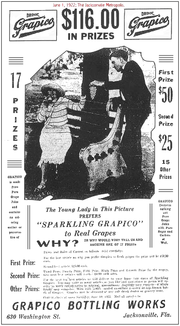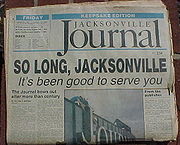
Jacksonville Journal
Encyclopedia

Newspaper
A newspaper is a scheduled publication containing news of current events, informative articles, diverse features and advertising. It usually is printed on relatively inexpensive, low-grade paper such as newsprint. By 2007, there were 6580 daily newspapers in the world selling 395 million copies a...
in the Jacksonville, Florida
Jacksonville, Florida
Jacksonville is the largest city in the U.S. state of Florida in terms of both population and land area, and the largest city by area in the contiguous United States. It is the county seat of Duval County, with which the city government consolidated in 1968...
area. It began publication as the Metropolis in 1887. Renamed The Florida Metropolis in the early 1900s, it was renamed the Jacksonville Journal in 1922 upon its purchase by John H. Perry. The Journal's new owner was known for his focus on the community and boosterism. He once proposed that the city change its name to 'Jackson' because the suffix '-ville' was belitting to a growing metropolis.
The Journal was historically the weaker newspaper in its rivalry with the local morning newspaper (The Florida Times-Union) and published only Monday through Friday.
The Journal branched out into local media outlets with a radio station and television station (both with the call letters WJHP). The television venture did not perform as well as expected because it was a UHF
Ultra high frequency
Ultra-High Frequency designates the ITU Radio frequency range of electromagnetic waves between 300 MHz and 3 GHz , also known as the decimetre band or decimetre wave as the wavelengths range from one to ten decimetres...
station (Channel 36) at a time when televisions required extra-cost converter boxes to access the station.
Perry died in 1952 and his death spurred speculation about the fate of his newspaper chain (which also included The Palm Beach Post). Rumors arose that the Hearst newspaper chain was going to purchase one or all of his holdings. For the rest of the decade Perry's sons managed the affairs of publishing. In 1959, the Times-Union's parent company - Florida Publishing Company - bought the Journal. Journal staff moved from their Laura Street building, where they had been since 1926, to the Times-Union's plant at 400 West Adams Street. The two papers worked as rival staffs in cramped quarters until they moved to a new location at One Riverside Avenue in 1967.
Although it had a smaller circulation, the Journal had its moments in the 1960s. When President Kennedy
John F. Kennedy
John Fitzgerald "Jack" Kennedy , often referred to by his initials JFK, was the 35th President of the United States, serving from 1961 until his assassination in 1963....
was assassinated, the Journal set records for evening readership with its Extra editions that kept locals updated about the tragedy. More copies would have been printed if the presses were not struck. The Journal later scored a major coup when one of its photographers won a Pulitzer Prize
Pulitzer Prize
The Pulitzer Prize is a U.S. award for achievements in newspaper and online journalism, literature and musical composition. It was established by American publisher Joseph Pulitzer and is administered by Columbia University in New York City...
in 1968. "The Kiss of Life" by Rocco Morabito
Rocco Morabito
Rocco Morabito was an American photographer who spent the majority of his career at the Jacksonville Journal....
depicted a city utility lineman reviving a colleague with mouth-to-mouth resuscitation atop a utility pole.
The Journal was a plucky younger sister to the Times-Union during the '70s and '80s. The Journal pioneered a special supplement for youth called "Action." The Journal, once known for including foil in its issues for cooking, made a tradition of printing on green paper for St. Patrick's Day.


